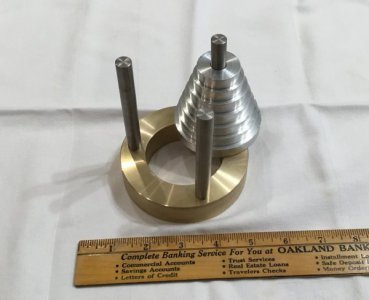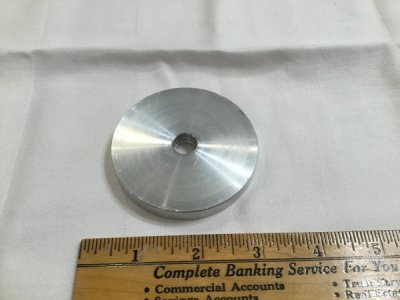Well, I did get it made, but I kludged it at half a dozen spots and while it sort of came out, I think after I get some advice and rethink it all, my second try is going to be much better...
To make a seven disk Tower of Hanoi (see first picture) I have to make seven disks. I am interested in what folks think should be a logical sequence of operations to make one of the disks (see second picture) Right now I am only interested in the disk creation. (The other two parts' sequence can also be improved, but I am starting the rethinking with the disks).
I start with rectangular flat aluminum. The disk has a specified OD, ID, and thickness. I have a 4x6 HF bandsaw, a PM1030V lathe (and a PM25MV mill if that might matter). I am not seeing clearly how to mount and remount the disk to get all four surfaces nicely machined (and dimensioned and square and plum and axially aligned) without marring from work holding.
Clearly this is like as beginner of a question as there can be--I am sure it must have been explained in that high school class but I have no memory.
Thank you for a proposed sequence. Or a pointer to where beginning stuff like this is covered.
-Bill


To make a seven disk Tower of Hanoi (see first picture) I have to make seven disks. I am interested in what folks think should be a logical sequence of operations to make one of the disks (see second picture) Right now I am only interested in the disk creation. (The other two parts' sequence can also be improved, but I am starting the rethinking with the disks).
I start with rectangular flat aluminum. The disk has a specified OD, ID, and thickness. I have a 4x6 HF bandsaw, a PM1030V lathe (and a PM25MV mill if that might matter). I am not seeing clearly how to mount and remount the disk to get all four surfaces nicely machined (and dimensioned and square and plum and axially aligned) without marring from work holding.
Clearly this is like as beginner of a question as there can be--I am sure it must have been explained in that high school class but I have no memory.
Thank you for a proposed sequence. Or a pointer to where beginning stuff like this is covered.
-Bill



